-

人教版高中英语必修3Festivals around the World说课稿3篇
Teaching plan for Unit 1 book3Good morning, teachers. It’s my great pleasure to be here because I can share my lesson with you and I can learn a lot from it. I’ll begin my lesson from the following four parts, the teaching material, the teaching methods, the studying methods and the teaching procedure.Firstly, let me talk about the teaching material. The content of my lesson is the reading passage festivals and celebrations of Unit 1 Festivals around the world. This passage is about festivals and celebrations. By studying this passage, we’ll enable the students to know that festivals exit everywhere, and many of festivals in different countries celebrate similar ideas. As we all know, the reading passage is the center of each unit. If the Ss can learn it well, it will be helpful to make the Ss learn the rest of this unit.After studying the teaching material, I think the teaching aims are as the followings:1. Knowledge aims:(1) The Ss can master the usage of the important words andexpressions.(2)The Ss can use the __________________ (grammar) in the proper situation.Make students know about the festivals all over the world and the detail of the festivals, such as origin, content, and the date of the holiday festivals.2. Ability aims:(1) Students can talk about festivals and celebrations in English(2) To improve the student’s reading ability, especially their skimming and scanning ability.3. Emotion aims:Make the Ss know about the foreign festivals, and respect other countries’ custom.Next, let’s come to the important points and the difficult points.The important point is how to make the Ss understand the text better and the difficult point is how can they talk about it. secondly, Teaching Methods:1. task-based Language Teaching2. Computer assisted language teaching.3. question-and–answer methodThirdly, Studying Methods:

人教版高中英语必修4Working The Land说课稿3篇
Knowledge objectives:(1) to make Ss grasp the usage of words, expressions and sentence structures: statistics, struggle, thanks to, rid of, some patterns for persuasion, the “ing” form as subject and object;(2)to use learnt knowledge to persuade sb.Ability objectives:(1) to develop Ss’ reading skills(skimming, scanning, word guessing);(2) to improve Ss’ speaking, communicating and cooperating skills.Emotional objectives:to make Ss know the contribution of Yuan,and learn his spirit and his simple life time.Teaching important and difficult points:(1) some words, expressions and sentence structures mentioned above;(2)the content of the text;(3)training their reading and speaking skills.Teaching methods: CLT, TBLT,QT.Learning strategies: CLS, QLS, TBLS.Teaching procedures:Step 1 lead-in: (1) teacher plays a piece of recent news from CCTV about the harvest of the super hybrid rice, and ask students whether they know Yuan or not, and talk about him and his contribution.(2)Brain storm: let Ss describe Yuan in their minds including his appearance, his living condition and so on.Step 2 fast reading tasks:(1)teacher introduces Yuan and super hybrid rice(2)make Ss read the text as fast as possible with questions. Such as: what’s the general ideaof this passage? What’s Yuan’ dream? (skimming and scanning skill)Step 3 intensive reading tasks(1)let Ss read the text silently, find topic sentence of each paragraph and draw the difficult sentences and the knowledge what they don’t understand.(words guessing)(2)teacher and Ss talk about the important words, expressions and sentences together, and ask Ss to retell the content of the text.(summarizing and paraphrasing)(3)teacher summarize this part.(4) read again following the courseware.

人教版高中英语必修3The million pound bank note说课稿3篇
在接下来的细读环节,我套用了高考对阅读理解的考查方式设置了5个问题,分别为三个推理判断题,一个细节题和一个主旨大意题。学生需要对文章的内容进行分析、归纳、推理、猜测等高级思维活动才能做出正确的回答。【设计意图】这一过程是对学生进行细读的训练,培养学生获取特定信息和挖掘文章深层次信息的能力。第三环节:Intensive-reading (精读) 15′第三个环节精读,既是最重要的环节,也是突破本课重难点的关键。首先,让学生思考剧本中人物看到百万英镑前后的态度发生了怎样的变化。其次,让学生仔细阅读文章,找出可以表现人物态度变化的具体的语言和动作。最后,让学生总结人物的态度发生变化的根本原因是什么,从而引出Money Talks, 供学生思考。【设计意图】通过一系列的活动培养学生学习从人物的语言和动作探究人物的心理,使学生进一步体会戏剧语言的魅力,从而对文章背后所反映的社会问题进行思考,也为下一步的讨论环节做好铺垫。

人教版高中英语必修5First aid说课稿6篇
In this class, I have 3 teaching aims, that is, knowledge aims, ability aims and emotion aims.1) Knowledge-Teach students new words and expressions, such as temporary, bleed,sprain choke, first aid, fall ill and so on.-Enable students to have a better understanding for some basic knowledge of first aid.2) Ability-Train students’ speaking, reading and writing abilities by different teaching activities, such as skimming, comprehending, team work, role play, retelling and writing.-Develop students’ reading strategy on how to move general idea to specific information.3) Emotion-Promote students’ awareness of giving first aid.- Cultivate students’ creativities.Then let’s come to my teaching methods and activities.III. Teaching methods and activities:To achieve different teaching aims, various kinds of teaching methods and activities will be adopted throughout this period, such as TBL (task-based learning), skimming, team work, brainstorm and others, which can offer students opportunities to fulfill tasks in which they can use language to achieve a specific outcome.IV. Teaching aids:Computer and blackboardV. Teaching important points:1) Make students have a clear mind for the structure of the text.2) Help students understand the theme of the text.VI. Teaching difficulties:1) So many new words may affect students’ understanding.2) How to get students to know about the functions of the skin and thecauses, characteristics and treatments for different degree burns,and the knowledge about giving first aid. VII. Blackboard design:

人教版高中英语必修5Making the news说课稿4篇
今天我们来介绍一下必修五第四单元的授课方式。这个单元的题目是Making the news。应该是学生比较感兴趣的话题,学生往往对新闻工作充满好奇,所以我们可以利用这个机会多设计一些师生互动和学生互动,来激发起学习的积极性,提高学习效率。同时我们可以利用这个单元不仅帮助学生掌握语言知识,培养语言能力,同时让其了解新闻工作的重要性,培养起社会智能感。这个单元分为六个课时,它的教学目标是这样的:语言目标是掌握词汇表中的常用单词和短语,掌握倒装句的一些基本用法。 技能目标是能初步掌握约会的基本句型并在真实的场景下正确运用。新闻报道类文章的写作技能。采访的基本规范和沟通技能。情感目标是对新闻报道的客观性和真实性有更好的理解。对新闻记者的职业有更深入的了解,并能体会其工作的重要性。下面我们来介绍一下第一课时的授课方式,第一课的教学目标是这样的第一课时的教学目标语言目标:单词:Occupation, journalist, editor, photographer, curious, personality, enthusiasm

人教版高中英语必修5The United Kingdom说课稿4篇
Teaching Aims:Knowledge 1. Get the students to learn the useful new words and expressions in this section. Aims:2. Let the students learn about how the UK was formed and the four groups of invaders.1. Develop students’ reading ability and let them learn different Ability reading skills. Aims:2. Enable students to learn to talk about the United Kingdom and the Union Jack Emotional 1. Let students know more about the UK2. Develop students’ sense of cooperative learning Aims:Teaching Important Points:1. Let the students learn about the countries of the United Kingdom and the Union Jack2. Get the students to read the passage and know about how the UK was formed and the four groups of invaders.3. Have the students learn different reading skills.Teaching Difficult Ponts:1. Develop students’ reading ability.2. Enable students to talk about the United Kingdom and the Union Jack.3. Let students learn how the UK was formed geographically and historically.Teaching Methods:Showing pictures, asking, exercising, listening, reading etc.Teaching Aids:A computer,a projector and a blackboard.Teaching Procedures: 1) Show a map of the world, ask students the following questions:Where is the UK?What’s the full name of the UK?2) Ask the students work in pairs to do the quiz on Page 9.Do you want to test how many things you know about the United Kingdom? Let’s have a small test.Using the map on P9, students answer the following questions:?How many countries does the UK consist of? What are they??England is divided into three main areas. Do you know what they are? 1) Scanning (10Minutes )Let the students hold the questions asked in pre-reading and read the passagequickly and then let them do the following exercise.Join lines to the right answer.

人教版高中英语必修2Wildlife Protection说课稿3篇
When it comes to the students’ studying methods, I'd like to introduce my Ss first. The Ss have a good command of basic language points. They’re interested in learning English, and they take an active part in English class, so they will have fun in autonomous, cooperative and inquiry learning. I will just serve as a guide, showing them the way to explore how to make more progress in their English learning.Now it’s time for the most important stage of this lesson. My teaching procedures are arranged as follows:Step1.Leading-in (3 minute)Play a video of a wide variety of wildlife to introduce my topic. Step2. Speaking (12 minutes)We will use our textbook Page25. Let the Ss fast read the short paragraph to warm up. Ask them to talk about the report on some endangered wildlife in China with the dialogue patterns on the screen. Lastly, I will invite some groups to demonstrate their dialogues about saving wildlife in China.Step3.English play (3 minutes)Watch another video in praise of their excellent performance just now. It’s about Jack Chen’s(成龙)and Yang Ziqiong’s wildlife protection.Step4. Listening (twice 13 minutes)This time, I’ll ask the Ss to fill in the blanks of the monologue of the 2 movie stars above. Step5.Discussion (3 minutes)Which would you like to choose to wear, clothes made of cotton, artificial leather or animal skins? Why ?Step6. Summary (3 minutes)1. If there were no wildlife, there wouldn’t exist human beings. If the buying stops, the killing can, too.2. Animals are our friends. To love animals is to love ourselves. Stop hunting, killing and destroying wildlife.3. Let’s live in harmony with all the living things in the world. Step7. Music appreciation (3 minutes)Let the Ss appreciate the song Earth Song by Michael Jackson. Last but not the least, I will show you my blackboard design.

人教版高中英语必修4Theme parks说课稿3篇
The oldest and the most popular park in the worldenjoy the exciting activities thereget close to the life-size cartoon characters like Mickey Mouse and Donald Duck Step 3 Pre-reading1.What do you suppose a theme park is ?2.What do you think you can see in a theme park?(1.It is a kind of amusement park which has a certain theme – that the whole park is based on. 2.buildings, castles, statues, rare animals and birds, and so on.) Step 4 Reading ----- Theme Parks –---- Fun and More Than Fun1.Predict : Read the title and the pictures on P. 34 and PredictWhat is the meaning of the title “Theme Park – Fun and more than fun”?(The title means that theme parks are fun to visit, but that they can also be educational and can offer useful information.)2.Skimming Fast read and answer:What activities can we take in a theme park?Amusement park: Bumper car Merry-go-round slide bungee jumping Free-fall rides Horror films Pirate ship Ferris wheel roller coaster3.Scanning Read again and you will find various theme parks are mentioned in the passage . Then what are they ?Theme parks: Sports theme park History theme park Culture theme park Marine or Ocean theme Park Future park Science theme park Disneyland4.Careful reading and find the main idea of each paragraph:THEME PARKS---- entertaining/ educationalPara.1 Traditional parks are places to go for relaxation and to have time away from our busy lives.Para.2 Theme parks are different They’re large and full of things to do, see and buy.Para.3 Theme parks are built around a single idea or theme. One example is a sports park.Para.4 Another kind of theme park is historical more and cultural and can be educational.Para.5 Disneylandwas the first theme park. It is based on the fantasy life and characters of Disney’s films.Para.6 Some examples of educational theme parks include sea world parks and science parks.

人教版高中英语必修5Great scientists说课稿4篇
通过写文章梗概,培养学生综合运用语言的能力,学习用恰当的英语描述科学家的故事。这是本课的教学难点。教师可以使用完形填空的方式来帮助学生整理语篇,从而来降低难度。本课的教学重点的突破方法是:在阅读前,让学生初步了解得出科学观点所需要的基本程序,从而轻松而自然地导入文章的阅读;在阅读过程中,由易到难设计快速阅读和精读的问题,层层推进各种阅读活动,让学生对阅读内容从整体感知到细节理解,最后深层读懂整篇文章,同时加强阅读策略的指导,让每个学生都主动参与课堂教学活动,最终达到提高阅读能力的目的。Step 4 Post-readingGroup Activities四人小组共同合作,在老师的适当指导下,就以下2个问题展开讨论,让学生就所知、所学、所感和所想融入话题,然后抽若干同学代表作小组发言。1. What do you think about John Snow, and what should we learn from him?2. Cholera was 19th century disease, which two diseases are similar to cholera today? Why?
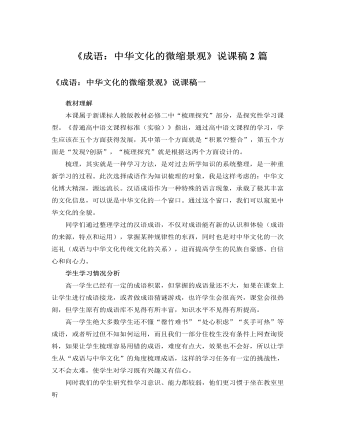
人教版高中语文必修2《成语:中华文化的微缩景观》说课稿2篇
(三)教学目标1、明确成语的来源,了解成语的结构特点。2、学习积累成语的方法。3、梳理学习过的成语,做到能正确理解、使用所学的常用成语。(四)教学重点和难点1、学习积累成语的方法。2、正确理解、使用所学的常用成语。二、说教法新的《高中语文课程标准》要求学生主动去发现问题、解决问题,教师是课堂学习的组织者、参与者,是课堂的主导,而不是课堂的主体。而且,新的课程标准要求学生“能围绕所选择的目标加强语文积累,在积累的过程中,注重梳理”。在这种前提下,本节课可以采取以下方法:由于这种梳理是对学生已有的知识进行归纳分类,可能显得比较枯燥。为了避免这种枯燥感,可以采取设置情境和分组竞答的方法,调动学生的积极性。
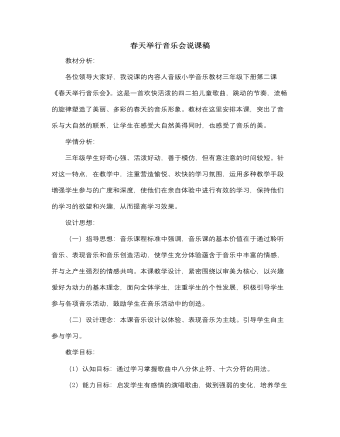
人音版小学音乐三年级下册春天举行音乐会说课稿
三、深入学习体验春之歌声——唱春天在新歌学唱环节,仍然以春天音乐会为主线,通过老师的导入“今天咱们就来学唱这次音乐会的主题歌《春天举行音乐会》,教师进行范唱,进而激发学好主题歌的愿望,再通过用“啦”模唱歌谱、有节奏的朗读歌词增强对歌曲的了解,音乐会节目的形式多样,除了它们四个音乐家独奏之外,还有合奏的地方,再提出滴答答答答︱沙沙0沙|沙沙?|轰隆隆隆隆|哗啦0啦|哗啦?|难点乐句中节奏的变化即十六分音符的用法,在学唱歌曲过程中,采用分角色接龙表演唱等形式,让学生在聆听中主动感受、体验歌曲的意境,并从歌曲的速度、力度等音乐要素出发,引导学生在参与表演中感受歌曲,感悟春雨的轻柔、春雷的有力,春水的热情、春笋的自豪应如何唱,重视学生思维的创造和发展过程,让学生明白怎样才能更好的表现歌曲,而不是单纯的停留在只是会唱歌曲的基础上,在此过程中进一步的培养了学生的音乐审美技能。四、创造表现,再现春之和谐。——颂春天
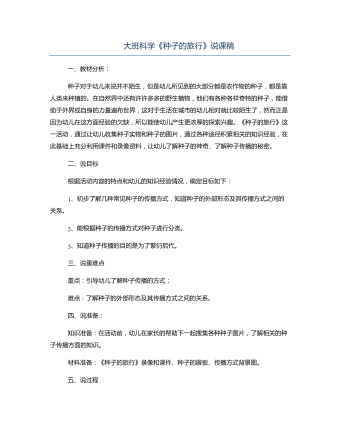
大班科学《种子的旅行》说课稿
种子对于幼儿来说并不陌生,但是幼儿所见到的大部分都是农作物的种子,都是靠人类来种植的。在自然界中还有许许多多的野生植物,他们有各种各样奇特的种子,能借助于外界或自身的力量遍布世界,这对于生活在城市的幼儿相对就比较陌生了,然而正是因为幼儿在这方面经验的欠缺,所以能使幼儿产生更浓厚的探索兴趣。《种子的旅行》这一活动,通过让幼儿收集种子实物和种子的图片,通过各种途径积累相关的知识经验,在此基础上充分利用课件和录像资料,让幼儿了解种子的神奇、了解种子传播的秘密。根据活动内容的特点和幼儿的知识经验情况,确定目标如下:1、初步了解几种常见种子的传播方式,知道种子的外部形态及其传播方式之间的关系。2、能根据种子的传播方式对种子进行分类。3、知道种子传播的目的是为了繁衍后代。

大班打击乐《斗牛士进行曲》说课稿
音乐与其他艺术一样,具有形象性特点,幼儿园音乐教育常常通过刺激幼儿的感知觉,去理解音乐中生动的艺术形象,情感与思想,为此,在教法的运用中我主要采用直观教具法,引导创造法,整体感知法,为什么采用以上的方法呢?因为,音乐具有形象性的特点,直观教具法可以使幼儿通过借助音乐电视、图形乐谱这些视觉材料帮助幼儿更好的感知音乐的情绪,风格,节奏,创造法是根据幼儿学习打击乐的特点而决定的,我班的幼儿从小班开接受欣赏、打击乐方面的训练,对音乐的风格、结构具有一定的分析能力,在教师指导下参与动作总谱、配器的设计,使幼儿能积极的运用自己所熟悉的音乐技能进行创造活动,在创造中获得了音乐能力的提高,同时也获得了快乐。
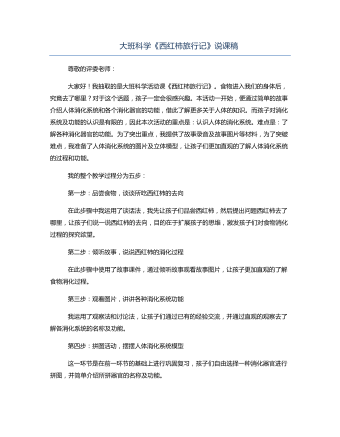
大班科学《西红柿旅行记》说课稿
我的整个教学过程分为五步:第一步:品尝食物,谈谈所吃西红柿的去向在此步骤中我运用了谈话法,我先让孩子们品尝西红柿,然后提出问题西红柿去了哪里,让孩子们说一说西红柿的去向,目的在于扩展孩子的思维,激发孩子们对食物消化过程的探究欲望。第二步:倾听故事,说说西红柿的消化过程在此步骤中使用了故事课件,通过倾听故事观看故事图片,让孩子更加直观的了解食物消化过程。第三步:观看图片,讲讲各种消化系统功能我运用了观察法和讨论法,让孩子们通过已有的经验交流,并通过直观的观察去了解各消化系统的名称及功能。第四步:拼图活动,摆摆人体消化系统模型这一环节是在前一环节的基础上进行巩固复习,孩子们自由选择一种消化器官进行拼图,并简单介绍所拼器官的名称及功能。
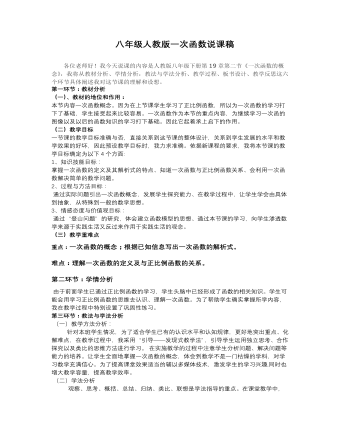
八年级人教版一次函数说课稿
1、知识技能目标:掌握一次函数的定义及其解析式的特点、知道一次函数与正比例函数关系、会利用一次函数解决简单的数学问题。2、过程与方法目标: 通过实际问题引出一次函数概念,发展学生探究能力、在教学过程中,让学生学会由具体到抽象,从特殊到一般的数学思想。 3、情感态度与价值观目标: 通过“登山问题”的研究,体会建立函数模型的思想、通过本节课的学习,向学生渗透数学来源于实践生活又反过来作用于实践生活的观念。

人教版高中语文必修1《黄河九曲:写事要有点波澜》说课稿
二、说学生本届高一学生经过了三年初中课改,在心理上,他们渴望表现的欲望和自主探究的欲望比较强烈,对有兴趣的知识表现出高度地热情,并具有一定的团结协作能力,但还是应该正视一个并不乐观的现实——在写作方面,学生知识还停留在简单的记叙及表达方式综合运用上,至于巧妙构思、谋篇布局很是空白。即便已经经过高中一个学期的学习,但还是有大部分学生依然基础较为薄弱,甚至出现不知从何下笔的现象。三、说教法与学法“老师搭台,学生唱戏”1、教法:本课将安排两课时(一课时学习一课时练笔),采用 PPT 多媒体课件教学,尝试用角色扮演法、图片展示法和多媒体教学等方法,教学中应该重视学生的参与性和探究性。2、学法:学生应该充分利用多角度创设的学习情境来激发自身学习的兴趣和热情,分组讨论,小组互助等形式让学生积极自主参与、进行问题探究学习。理论依据:建构主义理论“学生是学习的中心”的阐释,教师应该做学生主动建构意义的帮助者、促进者。

人教版高中语文必修1《人性光辉:写人要凸显个性》说课稿2篇
人教版新课标教材必修一的“表达交流”部分,有一个专题是“人性的光辉——写人要凸显个性”。其中的“写法借鉴”部分列举了两则人物描写实例,并归纳出人物描写的几个要点。其训练的思路和方法是很明显的,但所列举的人物描写的实例却不够典型。而必修一第三单元正好是学习写人记事散文,其中的两篇自读课文《记梁任公先生的一次演讲》《金岳霖先生》又是写人记事非常典型的文章,故而我尝试将这两篇文章作为实例和。写人要凸显个性。写作指导结合起来教学。这样设计还有一个目的,那就是解决课程改革中教学内容多而课时紧张的矛盾,提高课堂教学效率。师:今天,我们一起来学习“写人要凸显个性”。这两堂课分四个步骤来完成:一、先学习教材中关于写人方法的介绍,约15分钟;二、快速阅读第三单元的《记梁任公先生的一次演讲》和《金岳霖先生》两篇文章,具体感受其写人的方法,约30分钟;
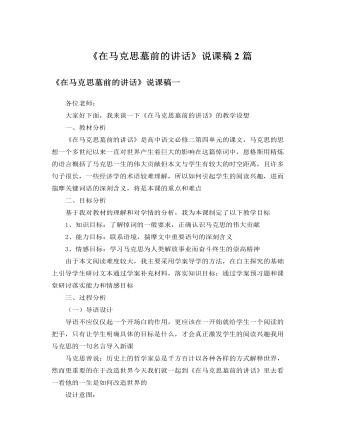
人教版高中语文必修2《在马克思墓前的讲话》说课稿2篇
(二)、课前检测:1.课文从哪几方面介绍马克思的伟大贡献?具体介绍一下有哪些伟大贡献?2.概述课文的结构。此项设置主要是让学生熟悉课文,为下文揣摩语言打基础。“温故知新”。(三)、新课讲授:1.先引导学生完成一些语句的揣摩理解,然后师生共同归纳揣摩重点语句的方法。问题1:为什么说马克思“停止思想”“安静地睡着了”“永远地睡着了”?问题2:讳饰修辞手法的运用有什么作用?答案:表达了作者对马克思的哀悼与尊敬以及不忍再说,而又不得不说的沉痛心情。以上两个问题重在引导学生从重点句段入手揣摩语言。问题3:第三段是一个复杂的单句,它的句子主干是什么?冒号后面作为宾语的复指成分可以分为哪几层意思?“正像达尔文……一样”在句子中是什么成分?起什么作用?
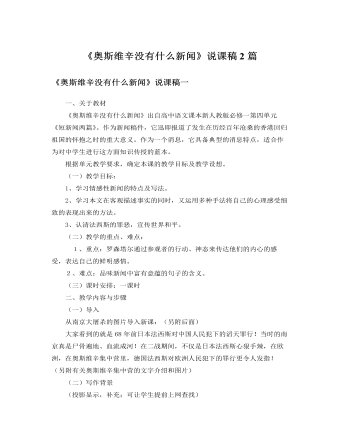
人教版高中语文必修1《奥斯维辛没有什么新闻》说课稿2篇
第11段很短,只点出了这是“在妇女身上搞不育试验的地方”,但在最末又加了一句“否则他会羞红了脸的”,这是为什么?那肯定是一个极为肮脏,极为残酷的地方。据资料记载:当时的希特勒制定一项令所有被征服或占领国家的民族充当奴隶并且逐渐消亡的隐密性种族灭绝计划——高效率、大规模的强制绝育。为此,数以百计的纳粹医生、教授、专家甚至护士,在行政管理专家的通力合作下,相继提出了几十种绝育方法,十余种实施方案,并且在奥斯维辛、拉芬斯布吕克、布亨瓦尔特、达豪等十多个大型集中营内对数以万计的犹太、吉普赛囚犯、因从事抵抗运动而被捕的政治犯和男女战俘进行了残酷的手术试验,造成他们大量死亡或者终身残疾、终身不育。这样残酷的毫无人性的手段,任谁也不愿看到。

人教版高中语文必修1《别了,“不列颠尼亚”》说课稿2篇
一、说教材《别了,不列颠尼亚》是编排在人教版《普通高中课程标准实验教科书语文1(必修)》第四单元的课文,是精读课文《短新闻两篇》中的一篇,另一篇是《奥斯维辛没有什么新闻》。这一单元的学习内容是新闻和报告文学,还有两篇作品分别是中国报告文学三大里程碑之一的《包身工》和记录中国航天事业辉煌发展的《飞向太空的航程》。在当今信息大爆炸的时代,如何快速获得信息,如何在新闻中解读事件的真相,感悟生活的内涵成为语文教学的又一重大任务。因此这一单元的编入便更多地具有了时代意义,体现了语文学科与日常生活的密切关系。不仅如此,新闻特写和报告文学的选入,拓宽了学生对新闻类文章的了解,体现语文学科的工具性作用。在选文的过程中,新教材同时注重语文学科的人文性,四篇作品不仅传递着新鲜、真实的信息,同时更张显人文性的厚度,他们以饱满的情感,纵横的历史经验。

